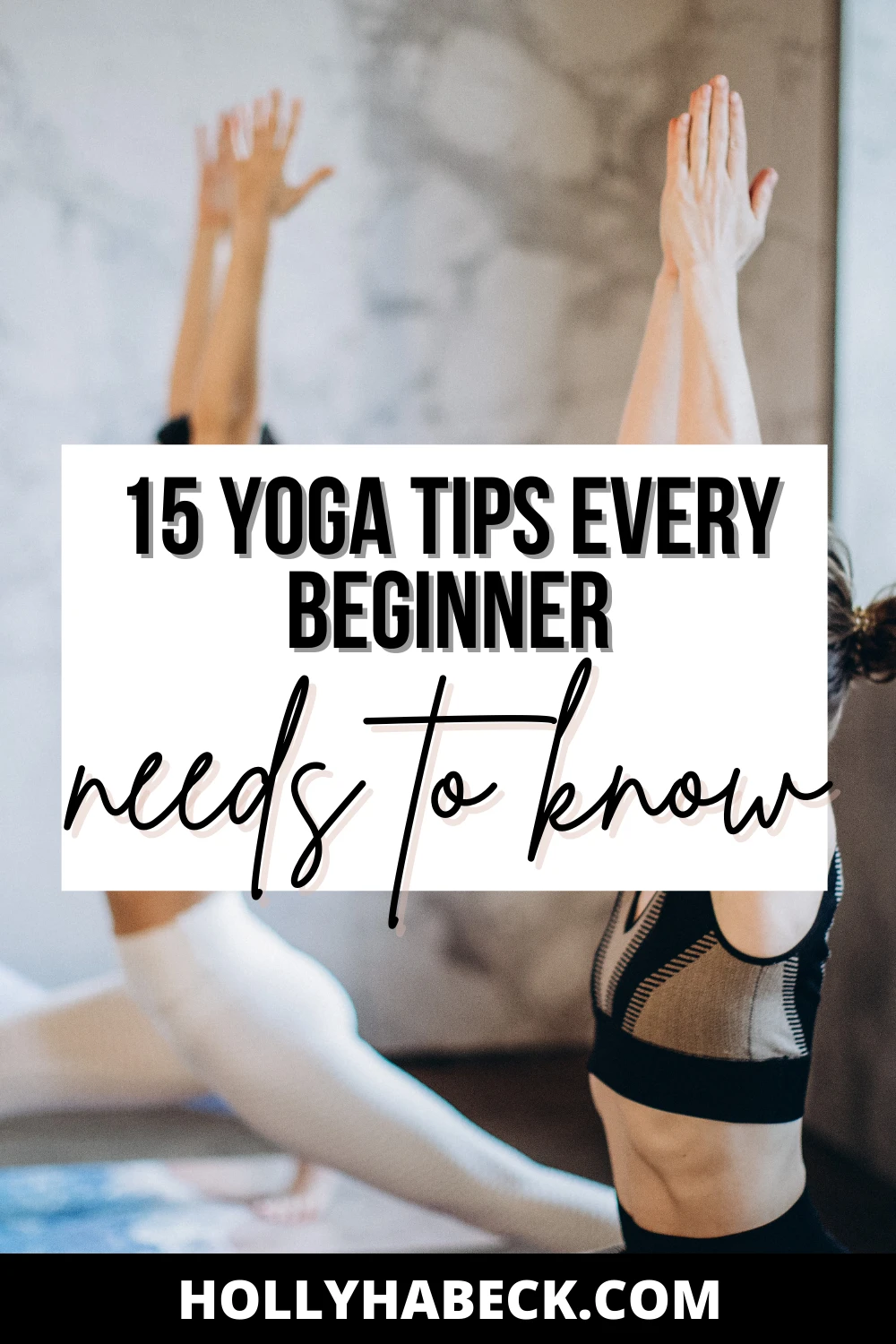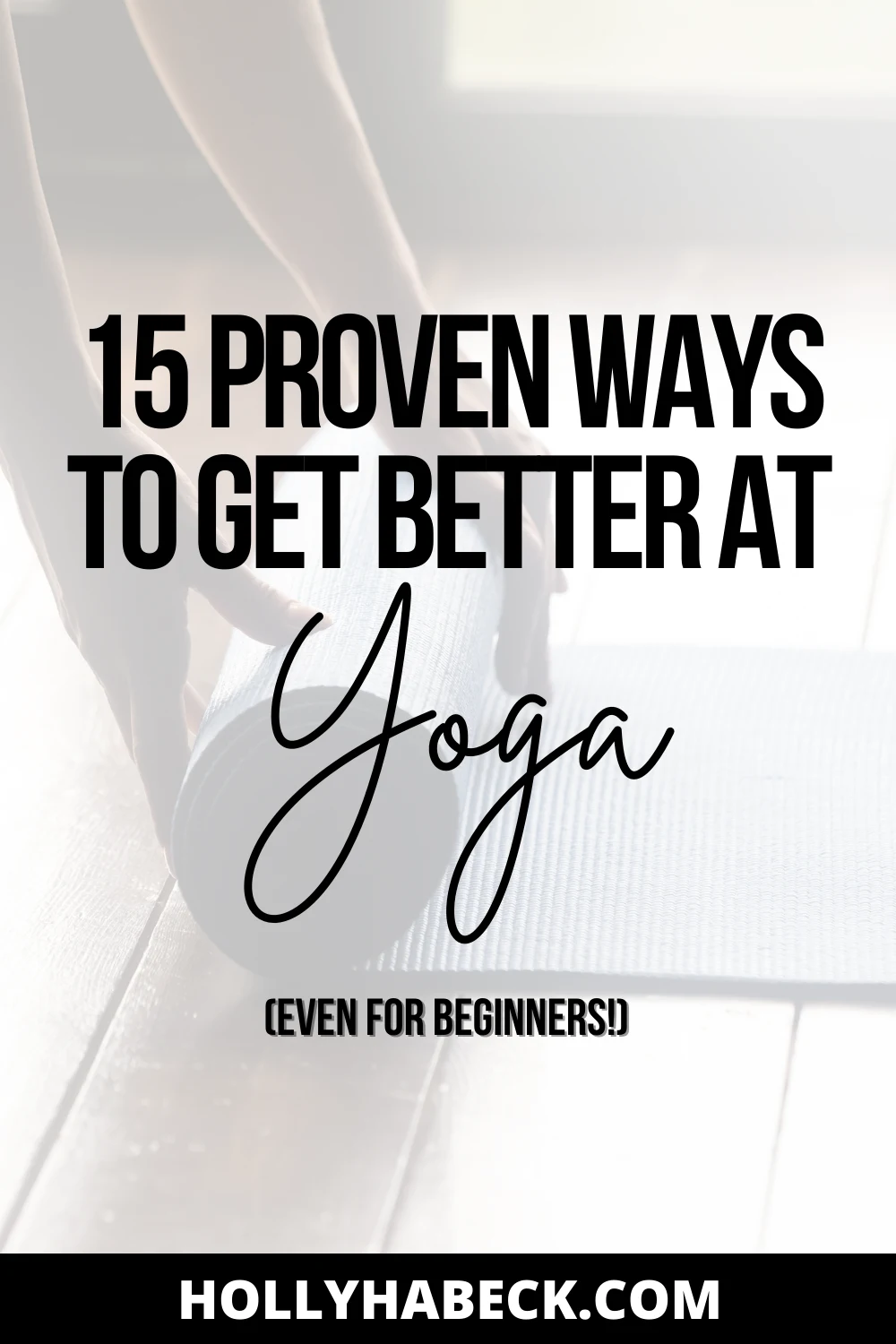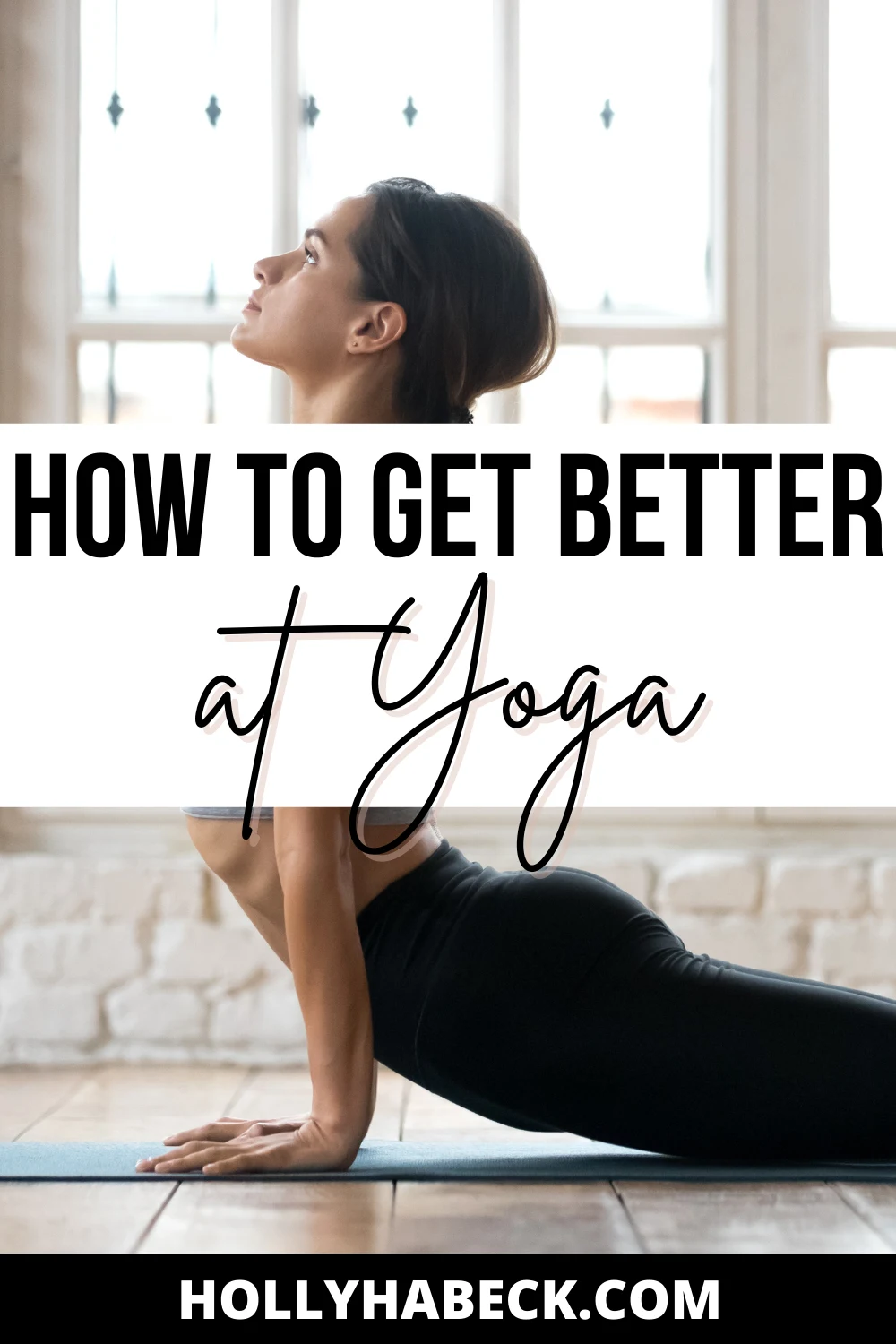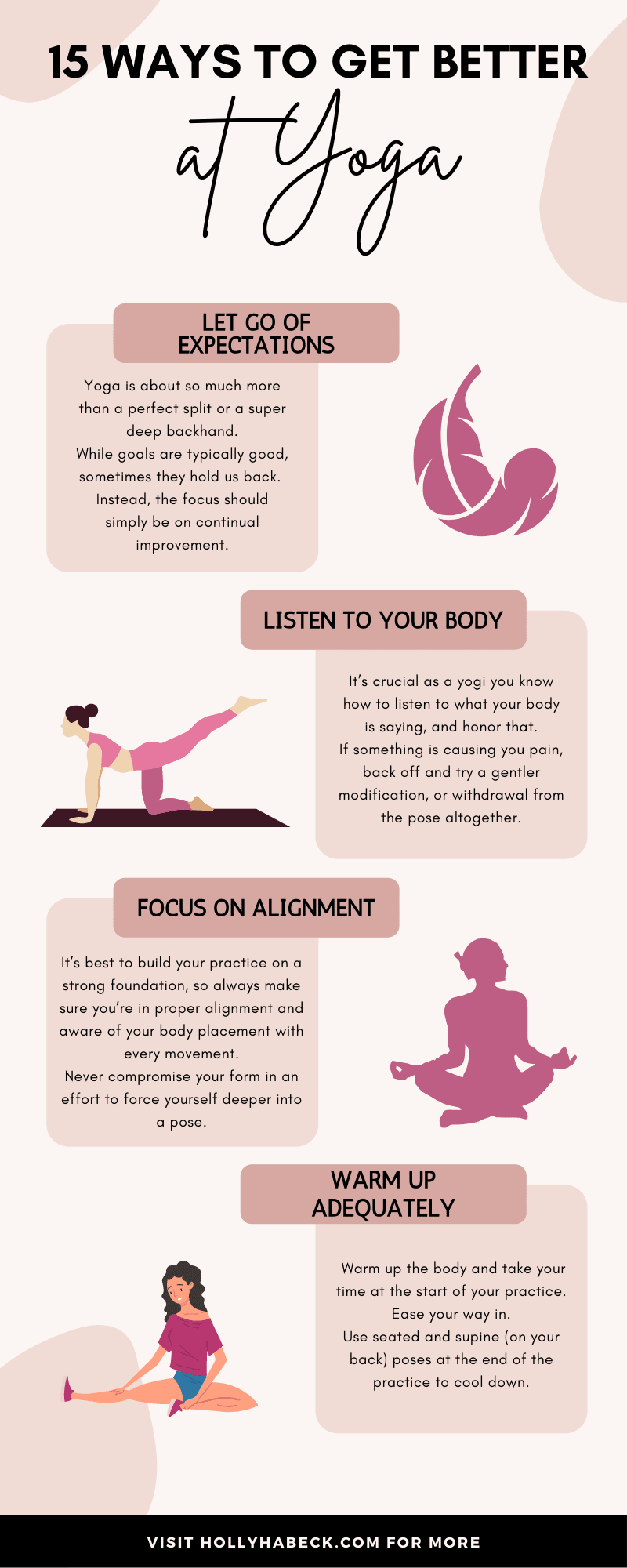Navigating the world of yoga and learning the ins and outs of the practice can be overwhelming and tricky — here is how to get better at yoga with 15 tips to deepen your practice!
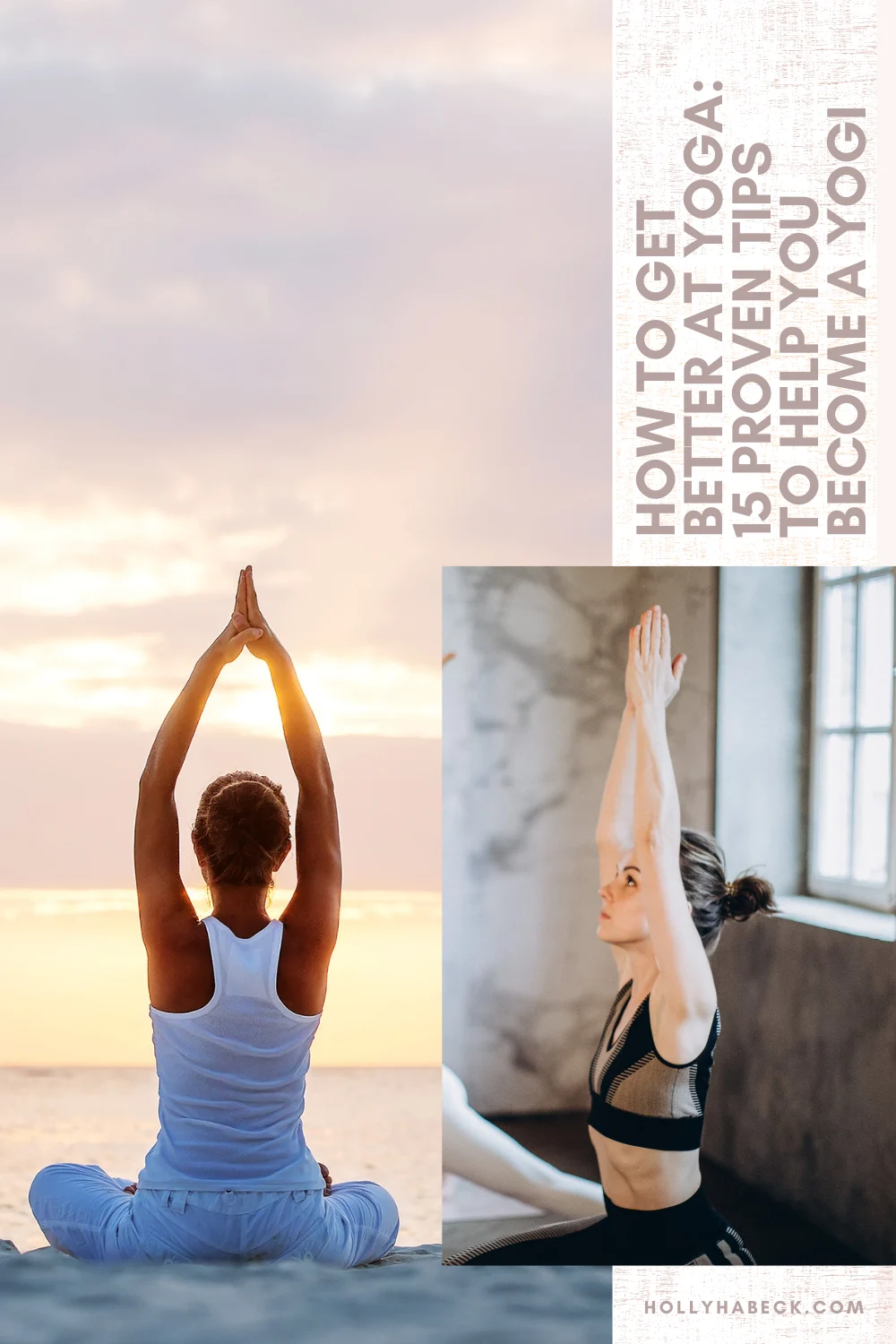
As an Amazon Associate I earn from qualifying purchases. Therefore, this post may contain affiliate links, meaning I make a small commission on qualifying purchases made through these links, at no additional cost to you.
What is a Yogi?
The practice of yoga is ancient, and has evolved over a long period of time.
The practice was created as a way for yogis (those who practice yoga) to be closer to the divine, by preparing the mind for enlightenment.
According to Patanjali’s second yoga sutra, yoga is the practice of mastering the mind and eliminating fluctuations/modifications of the mind.
When one can be free of the mind’s limitations, one can be closer to divinity, enlightenment, and total joy.
Using the body as a means of learning to endure discomfort became a tool, and the yogis learned that by relieving tension in the body, one could break down “stuck” emotions, and become closer to source energy (ie. Universe, Divinity, God).
To be a yogi, you don’t have to be able to put your feet behind your head or do a perfect scorpion handstand.
However, you must dedicate yourself to regular and consistent practice that allows you to journey inward and cultivate awareness.
Yoga is about cultivating a calm and equanimous mind, and showing up every day to the mat to dedicate yourself to practice (even if it is just sitting on a meditation cushion!).
Related: Flat Belly Detox Water — Easy, 3 Ingredient Recipe
Is Yoga hard?
Yoga is not inherently hard, however it’s quite natural in the practice to continue to grow until we find ourselves doing things physically that are remarkable to those without experience.
The mental fortitude and focus required to sit in concentrated meditation also may appear “hard” to the outsider.
However with small steps and consistent work, it is possible to do what was once impossible — or so it once seemed.
Also, if we are to use physical asanas as a way to develop our sense of focus and discipline, or ability to withstand discomfort, it is true that we must continue to increase the difficulty of our practice to reap the same benefits.
Otherwise we will become accustomed to the practice, and ultimately it will come with ease.
We must continue to be challenged to continue reaping the maximum potential of our practice.
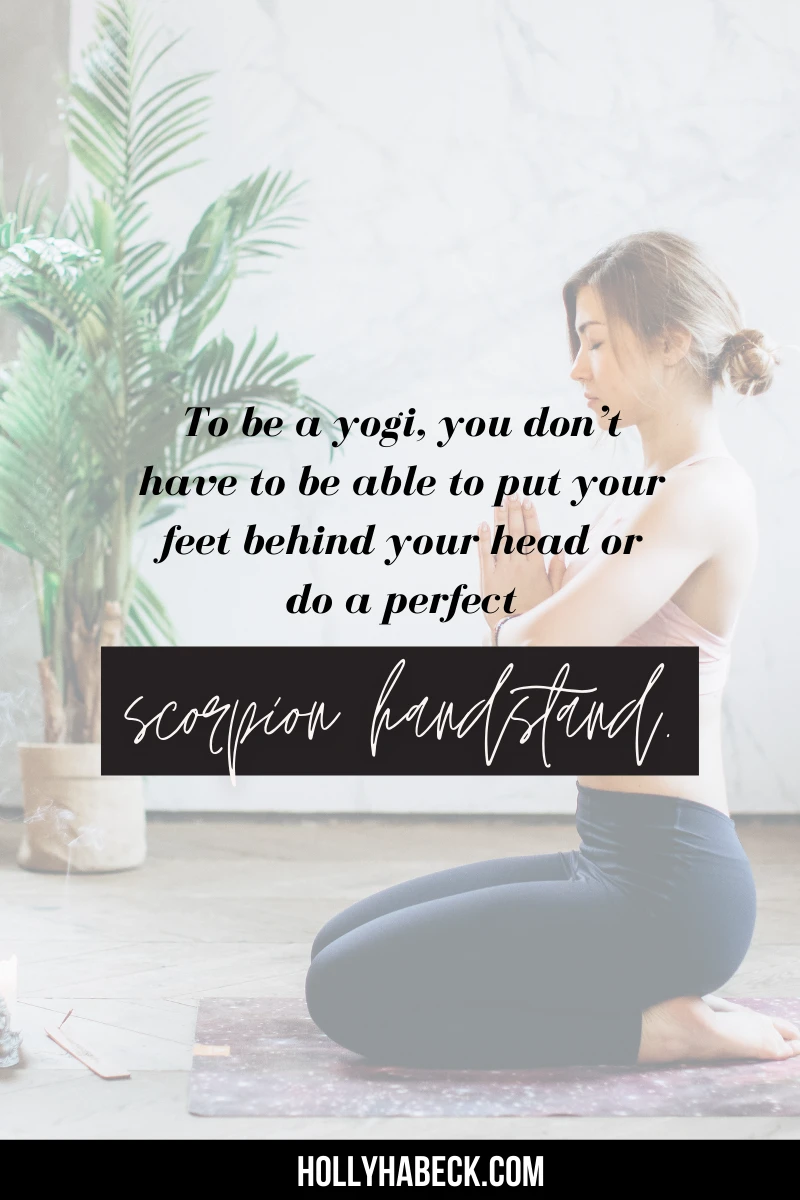
How to Start Yoga
Yoga can be quite simple, with a brief mindful meditation or breathing exercise.
You can find lots of credible instructors online by searching YouTube or Patreon.
Instructors such as Kino MacGregor, Adell Bridges, or Cathy Madeo have been around for some time, developed a steady following and reputation, and now offer lots of free classes online.
Just search for beginner classes and there are all kinds with different goals and intentions.
Once you are comfortable with the basics, you can search for a studio near you and select an instructor and class after researching the yoga style and instructor.
It’s a good idea to experiment with different teachers and styles to learn what you like.
How to Get Better at Yoga: 15 Proven Tips to Help You Become a Yogi
1. Let go of expectations and shift your focus away from working to look a certain way
Yoga is about so much more than a perfect split or a super deep backhand.
While goals are typically good, sometimes they hold us back.
Okay so we finally got a handstand…now what?
Instead, the focus should simply be on continual improvement.
There is always more we can do deepen our practice, and truthfully there is no perfect asana (asana is Sanskrit for seat, meaning the physical postures, which originally were seated postures for meditation).
Doing what is reasonable for your body and doing what serves you best in the present moment is the best approach, as a way to honor your Self and your body.
2. Listen to your body
It’s crucial as a yogi you know how to listen to what your body is saying, and honor that.
If something is causing you pain, back off and try a gentler modification, or withdrawal from the pose altogether.
On days when you’re extra sore and you haven’t had much time in your schedule to just relax, give yourself a gentle restorative flow to rest and rejuvenate.
We can’t just go through the motions in yoga.
It is a practice that requires us to have total awareness over our physical and mental state, and understand how to give ourselves what we need in this moment.
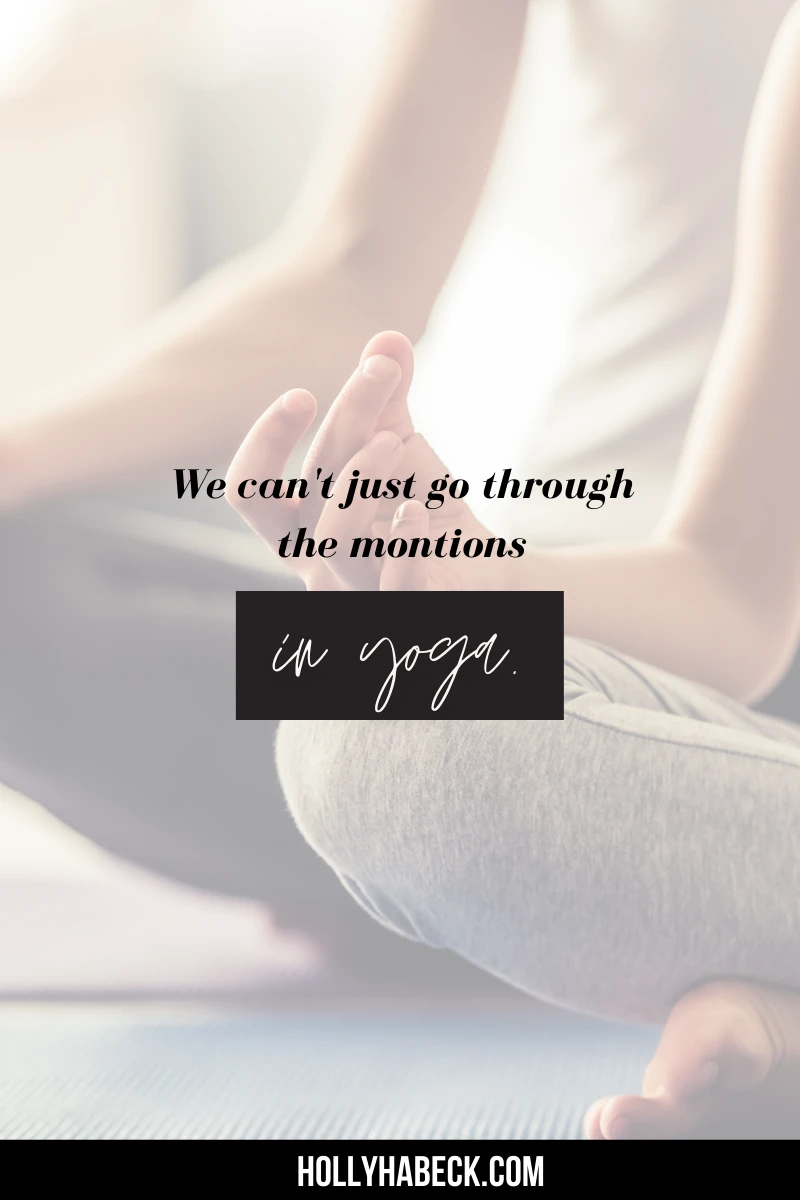
3. Focus on proper alignment instead of rushing into fancy variations
It’s best to build your practice on a strong foundation, so always make sure you’re in proper alignment and aware of your body placement with every movement.
Never compromise your form in an effort to force yourself deeper into a pose.
It can be tempting to do this when we constantly see all these images on Instagram, but remember it took these yogis a long time to get to where they are today, and patience is key!
After you begin to access these beginner variations with ease and proper alignment, then you can begin to develop the asana further, one small step at a time.
4. Warm up adequately at the start of each practice
Warm up the body and take your time at the start of your practice. Ease your way in.
Use seated and supine (on your back) poses at the end of the practice to cool down.
Sample Yoga Warm Up Ideas
You can begin with simple neck rolls or shoulder rolls (always switching half way to the opposite direction).
Cat cows are also a great warm up.
Staring on all fours, with every inhale you will drop the belly down as you reach your seat bones up (stick your bum back), and reach the gaze up.
Your shoulder blades will come together on your back. You can also tuck your toes under.
As you exhale, untuck the toes, and beginning at the pelvis move the spine in a fluid wave to arch the opposite direction (like a cat stretching it’s spine upwards) as you pull the belly button into the spine with the strength or your abdominals, and lower the gaze towards the knees.
Continue this fluid cycle at the pace of your own breath.
Stretch the wrists out by placing the palms down with the fingers pointing towards your knees and lean back into the hips.
Then, take several sun salutations (surya namaskar in Sanskrit).
Sun sal A is the most fundamental.
Sample Sun Salutation Sequence
Root down in mountain pose (stand tall and firm with the palms facing forwards).
Inhale while reaching the arms up to urdhva hastasana (upward salute).
Exhale while hinging forward at the hips to forward fold (ustrasana).
Inhale lift half way with the spine parallel to the floor, hands at the shins.
Exhale and plant the palms on the ground and take plank position, with the hips in line with the shoulders. Inhale to prepare.
Exhale into chaturanga as you bend the elbows (and keep them tucked in by your sides) as you lower down, keep the elbows above the wrists, stop at 90 degrees (you can do this on the knees).
Inhale and straighten the back as you reach the head up and drive the hips down and take a back bend (upward facing dog or urdhva mukha shvanasana).
Next, send the hips back and up as you take a forward fold in a pike position with the hips up (you are in an upside down “V” position).
Bend the knees as needed.
This is downward facing dog (adho mukha shvanasana).
Come up on the balls of the feet, let the gaze come between the hands, and take small steps towards the front of the mat.
Once you get to the front, exhale and fold forward.
Inhale lift halfway (spine parallel to floor), exhale rise all the way up, sweep the arms up and take the gaze to the ceiling.
Gather all your energy as you bring your palms together and lower them through the third eye and heart chakras to your chest.
Repeat as desired.
Watch some beginner classes on YouTube to get a feel for a typical flow and more in depth tutorials.
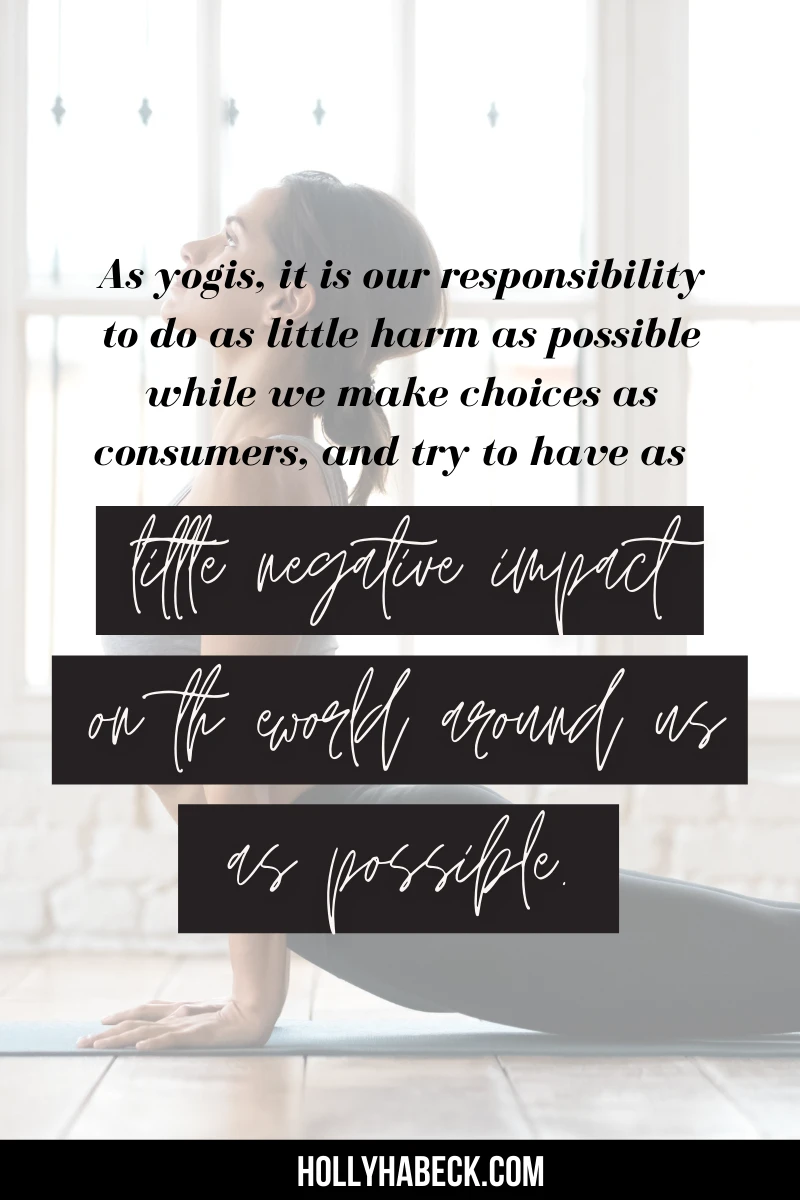
5. Practice Savasana
Savasana is Sanskrit for corpse pose, and it is our final resting pose at the end of practice.
It is good to take savasana for 2-10 minutes at the end of practice, because this allows our practice to fully integrate.
It is a time when we can meditate and momentarily leave the physical body.
Try adding it to the end of your practice by simply lying on your back and let the body take whatever position it naturally assumes.
Place the palms up to recharge your energy, or palms down to let go of unwanted energy.
6. Link breathe to movement
It is important to learn how to breathe with your movements.
As a general rule of thumb, we inhale when we do back bends, and exhale when we fold forward.
Using your breathe to guide movements will allow you to go deeper into poses, and to synchronize the mind and body, as well as cultivate more awareness.

7. Keep the mind steady and calm
The more you are able to quiet the mind, the more successful you will be at navigating postures and sequences that challenge your strength and flexibility.
Just keep reminding yourself that you are not in danger, you are safe, and you are not in pain…just experiencing some slight discomfort while you practice yoga.
Reminding yourself that you are safe to allow the body to let go gives you that extra push to keep going.
Of course if you have an injury or are doing something improperly, you may experience real pain.
You know your body, and you know the difference between pain and discomfort.
If experiencing pain, always back off and seek guidance from your teacher.
8. Invest in comfortable clothing that moves with you, instead of hindering your mobility
These Wolven leggings are so cute and move WITH you!
They have lots of different colors available, matching tops, and even shorts if you prefer something cropped.
Wolven is a great brand of yoga clothing because one of their main focuses is sustainability.
They use recycled ocean plastic to make a lot of their fabrics, and minimize their overall carbon foot print.
As yogis, it is our responsibility to do as little harm as possible while we make choices as consumers, and try to have as little negative impact on the world around us as possible.
This is in line with one of the concepts in the first of eight limbs of yoga called yamas, or restraints.
The first of five yamas is called ahimsa in Sanskrit, or non-violence.

9. Check out classes on Alo Moves
Alo Moves is a collective with all kinds of instructors with various styles and approaches.
You can get a free trial to test the waters, and afterwards pay 20/month or 99/year.
This is a lot cheaper than paying a membership at a studio!
Plus, you get to practice right from home!
Whether you want to learn the basics of yoga, or practice more advanced techniques such as handstands or deep back bends, Alo Moves will certainly have a class available for you.
10. Invest in some yoga props
You don’t have to spend a lot of money, but using props such as blocks, wheels, straps, a bolster, and of course a mat can be super useful in the beginning (here is an affordable yoga block and strap set to get started with!).
These tools will allow you to have proper alignment even before you have the flexibility or openness to access certain variations of different asanas.
For example , we can use a strap around the sole of the foot while practicing padangusthasana (big toe to hand pose) until we have the flexibility through our hamstring to do it without the strap.
Using blocks under the hands in poses such as trikonasana (triangle pose) or extended side angle will give you a little bit of extra space so that you can open up through the chest and front body instead of collapsing down and crunching through the side body.
You can always look up tutorials to use these props or how to use props to modify any pose you may be struggling with.
Many yoga teachers will automatically include these modifications in their classes, and you can always ask your teacher for a modification using a prop.

11. Practice consistently
Even if you can only make one actual yoga class per week, it is important that you practice what you have learned on the remaining 6 days of the week.
If you like you can take a rest day, but practicing as close to every day as possible will ensure that you grow in your practice and gain strength, endurance, and flexibility.
Even if you can’t always practice for an hour, getting on the mat for 20 minutes will be better than not at all.
Always aim to just get on the mat, and once you start the hardest part is already over!
Sometimes just initiating our practice can be the difficult step that holds us back.
12. Practice different styles of yoga
You might find you gravitate towards certain styles of yoga more than others, or that some styles come more easily to you.
It’s best to have a well rounded practice, and you’ll want to change up your flow to stay on your toes and continue to challenge yourself.
Practicing power flows will give you strength, endurance, and sharpen your sense of discipline and willpower.
Yin yoga will release the myofascial matrix, or the webbing that supports our muscles.
Vinyasa will give you a well rounded flow while strengthening the body and opening up the hips and shoulders and tight muscles.
If your practice is the same every day, at some point it will no longer give us the challenge of a novel flow.
So vary your routine, and seek out new classes at local studios or on YouTube or Alo Moves to stay inspired.

13. Use a balance of active and passive stretching
Passive stretching is what it sounds like.
You stretch your muscles by taking a position and letting gravity do the work.
For example, a split or a forward fold.
Active stretching is when you engage a particular muscle or group of muscles in order to stretch an opposing muscle or muscular group.
For example, a standing split requires you to engage your gluteus medius in order to open the hip and stretch the posterior chain.
Or, in a forward fold, you can engage the quadriceps, which will raise the knee caps and harden the front of the thigh, in order to more deeply stretch the hamstring (the back of the thigh).
Mixing these styles of stretches will help you make more progress as you journey through flexibility, strength, and mobility.
14. Build asanas from the ground up
As you make your way into each pose, build it from the ground up.
Meaning, start by making sure your feet are in proper position, alignment, weight distribution…then work your way up to the legs, hips, torso, chest, arms, shoulders, head, and finally gaze.
This will ensure you build a solid foundation for the pose, and that you are able to hit each alignment point as you transition into each posture.
15. Cool the body down properly at the end of a vinyasa or power flow
Just as we must adequately warm up, we must also adequately cool down.
Once we spend a good three quarters of our practice warming up, working up a sweat, and flowing through vinyasas, it’s good to take it to the floor and move through some asanas that are seated and then supine (on our back).
This helps shape the flow in a way that eases us into and out of our practice, and prepares us for savasana at the end of class.
After a rigorous class, post savasana, we can roll into fetal position on our right side, as this side is cooling.
However, if our practice was yin based, which is slower and incorporates deeper stretches, we can roll into fetal position on our left side after savasana, which helps stimulate and warm us back up after a very relaxing and calming class.
These type of nuances can take your flow to the next level!
As you begin to incorporate these tips into your daily yoga, you will notice you are able to deepen your practice on a physical and spiritual level.
Which one of these tips on how to get better at yoga do you think will have the biggest impact on your practice?
Pin This Post:
